Circassia
Circassia (/sɜːrˈkæʃə/; Adyghe: Адыгэ Хэку) is a region in the North Caucasus and along the northeast shore of the Black Sea.[1] It is the ancestral homeland of the Circassian people.
Circassian Confederation Адыгэ Хэку - آدیه حَقُو - Adıǵe Xeḱu Адыгей - Adıǵey | |||||||||||||
|---|---|---|---|---|---|---|---|---|---|---|---|---|---|
| c. 1427–1864 | |||||||||||||
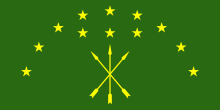 Flag
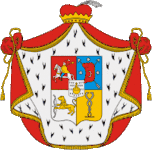 Coat of arms
| |||||||||||||
Motto: Псэм ипэ напэ Psem yipe nape "Honor comes before life" | |||||||||||||
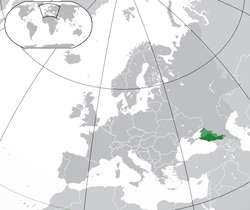 Circassia in 1763 | |||||||||||||
| Capital | Sochi | ||||||||||||
| Common languages | Adyghe | ||||||||||||
| Religion |
| ||||||||||||
| Government | Confederation | ||||||||||||
| History | |||||||||||||
• Established | c. 1427 | ||||||||||||
• Russian–Circassian War | 1763–1864 | ||||||||||||
• Disestablished | 1864 | ||||||||||||
| |||||||||||||
Name
The name Circassia is a Latinisation of Cherkess (modern Turkish: Çerkes), the Turkic name for the Adyghe people and according to R. G. Latham originated in the 15th century with medieval Genoese merchants and travellers to Circassia.[2][3] Another opinion is that "Circassia" and "Cherkess" are distorted variants of Kerketh or Toreatae, one of the names of the tribes of the Adyghe people. The name Cherkess is traditionally applied to the Adyghe by neighbouring Turkic peoples (principally Crimean Tatars[4] and Turkish people).[5]
Another historical name for the country was Zyx or the Zygii, who were described by the ancient Greek intellectual Strabo as a nation to the north of Colchis.
At the end of the 15th century, a detailed description of Circassia and of its inhabitants was made by Genoese traveller and ethnographer Giorgio Interiano.[6]
Geography
.jpg)
Circassia was located in Eastern Europe, near the northeastern Black Sea coast. Before the Russian conquest of the Caucasus (1763–1864), it covered the entire fertile plateau and the steppe of the northwestern region of the Caucasus, with an estimated population of between 3 and 4 million.
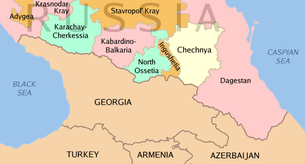
Circassia's historical great range extended from the Taman Peninsula in the west, to the town of Mozdok in today's North Ossetia–Alania in the east. Historically, Circassia covered the southern half of today's Krasnodar Krai, the Republic of Adygea, Karachay-Cherkessia, Kabardino-Balkaria, and parts of North Ossetia–Alania and Stavropol Krai, bounded by the Kuban River on the north which separated it from the Russian Empire.
On the Black Sea coast the climate is warm and humid, while being moderate in the lowlands and cooler in the highlands. Most of Circassia is frost free for more than half the year. There are steppe meadows in the plains, beech and oak forests in the foothills, and pine forests and alpine meadows in the mountains.[7]
Sochi is considered by many Circassians as their traditional capital city.[8] According to Circassians, the 2014 Winter Olympic village is built in an area of mass graves of Circassians after their defeat by the Russians in 1864.[9]
History
The earliest definite evidence in the history of Circassia shows that the Greeks established colonies and traded along the Circassian coast of the Black Sea, leaving behind a clear influence. Nevertheless, Circassia remained relatively independent until the 12th and 13th centuries, when it became a province of Georgia. However, in 1234 the Caucasus region was overrun by the Mongols, and the region came under the rule of the Crimean Tatars.
- 1237: Historian Rashid-ad-Din in the Persian Chronicles, wrote that the Circassian king Tukar was killed in battle against the Mongols.[10]
- 1333: In his letter, Pope John XXII (to the king of Zichia (Circassia) Verzacht ["Верзахта" in Cyrillic script]), the Rome (Avignon) Pontiff thanks the Governor of Circassians for his assistance in implementing the Christian faith among the Adygs (Circassians).[11] Verzacht's power and status was so high that his example was followed by the rest of the Circassian princes: They took the Roman Catholic faith.
- 1471: A contract was signed between the ruler of Circassia and the ruler of Caffa, naming another ruler of Zichia - "Petrezok, the paramount lord of Zichia".[12] Under the contract, Zichia would supply large quantities of grain to Cаffа.
- The region was famed for its beautiful women, many of whom were married to the Ottoman sultan and Persian Shahs and had influential positions in the Imperial Harem.
Conquest by Russia
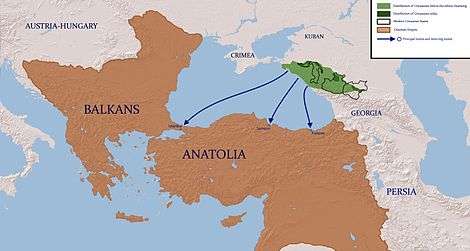
As part of its conquest of the Caucasus, the Russian empire became involved in a series of wars and battles in Circassia, starting in the late Eighteenth Century and building in intensity to 1864, when the war was declared over. From the 1860s the Russian policy became one of ethnic cleansing and mass expulsion of the population from their country to the neighboring Ottoman Empire, events that have become known as the Circassian genocide.
Among the main Circassian tribes that were affected by death or deportation were the Shapsugs, Kabardins, Abzakhs and Natukhajs. It is estimated that the population of Kabardins in Circassia was reduced from 500,000 to 35,000; the Abzakhs from 260,000 to 14,600; and the Natukhajs from 240,000 to merely 175 persons. [13] The Shapsugh tribe which numbered some 300,000 were reduced to 3,000 people. Calculations, including those taking into account the Russian government's own archival figures, have estimated a loss of 90%,[14][15] 94%[16] or 95–97%[17] of the original Circassian population.
Population
There are twelve historic Adyghe (Circassian: Адыгэ, Adyge) princedoms or tribes of Circassia (three democratic and nine aristocratic); Abdzakh, Besleney, Bzhedug, Hatuqwai, Kabardian, Mamkhegh, Natukhai, Shapsug, Temirgoy, Ubykh, Yegeruqwai and Zhaney,[18]
Today, about 700,000 Circassians remain in historical Circassia in today's Russia. The 2010 Russian Census recorded 718,727 Circassians, of which 516,826 are Kabardians, 124,835 are Adyghe proper, 73,184 are Cherkess and 3,882 Shapsugs.[19] The largest Circassian population resides in Turkey (pop. 1,400,000 – 6,000,000).[20][21] A Circassian population also exists in other countries, including Jordan, Syria, Iraq, Iran, Lebanon, Serbia, Egypt and Israel, but is considerably smaller.[22][23]
Circassian nationalism
Under Russian and Soviet rule, ethnic and tribal divisions between Circassians (and other peoples) were promoted, resulting in several different statistical names being used for various parts of the Circassian people (Adyghes, Cherkess, Kabardins, Shapsugs). Consequently, Circassian nationalism has only recently developed and there is an effort among Circassians to unite under the name Circassian (Adyghe) in Russian Censuses to reflect and revive the concept of the Circassian nation. Circassian nationalism also calls for a restoration of the native homelands. The majority of the diaspora already tends to call itself "Circassian".
See also
- Circassian Assembly
- Circassian beauties
- Circassian coast
- Circassian Day of Mourning
- Circassian diaspora
- Circassian Genocide
- Circassian language
- Circassian music
- Circassian nationalism
- Circassian people
- Russian–Circassian War
References
- Chisholm, Hugh, ed. (1911). . Encyclopædia Britannica. 6 (11th ed.). Cambridge University Press. pp. 380–381.
- Latham, R. G. Descriptive Ethnology. London, J. Van Voorst, 1859. p. 50.
- Latham, R. G. Elements of Comparative Philology. London, Walton and Maberly, 1862. p. 279.
- Taitbout, De Marigny. Three Voyages in the Black Sea to the Coast of Circassia. London, 1837. pp. 5–6.
- Guthrie, William, James Ferguson and John Knox. A New Geographical, Historical and Commercial Grammar and Present State of the Several Kingdoms of the World ... Philadelphia, Johnson & Warner, 1815. P. 549.
- Biblioteca Italiana.Vita de' Zichi chiamati Ciarcassi di G. Interiano (in Latin)
- "Circassians". www.encyclopedia.com. Retrieved 20 June 2019.
- Home thoughts from abroad: Circassians mourn the past—and organise for the future. The Economist. 2012-05-26.
- Spelen zijn op massagraven. Nederlandse Omroep Stichting 2014-02-03
- Рашид ад-Дин. Сборник летописей. М.-Л., 1952. Т. 2. С. 39
- Колли Л. Кафа в период владения ею банком св. Георгия (1454—1475) // Известия Таврической Ученой Архивной комиссии. № 47. Симферополь, 1912. С. 86
- Kressel R. Ph. The Administration of Caffa under the Uffizio di San Giorgio. University of Wisconsin, 1966. P. 396
- А.Суриков. Неизвестная грань Кавказской войны Archived 2013-08-19 at the Wayback Machine(in Russian)
- "145th Anniversary of the Circassian Genocide and the Sochi Olympics Issue". Reuters. 22 May 2009. Retrieved 28 November 2009.
- Barry, Ellen (20 May 2011). "Georgia Says Russia Committed Genocide in 19th Century". The New York Times.
- Sarah A.S. Isla Rosser-Owen, MA Near and Middle Eastern Studies (thesis). The First 'Circassian Exodus' to the Ottoman Empire (1858–1867), and the Ottoman Response, Based on the Accounts of Contemporary British Observers. Page 16: "... with one estimate showing that the indigenous population of the entire north-western Caucasus was reduced by a massive 94 per cent". Text of citation: "The estimates of Russian historian Narochnitskii, in Richmond, ch. 4, p. 5. Stephen Shenfield notes a similar rate of reduction with less than 10 per cent of the Circassians (including the Abkhazians) remaining. (Stephen Shenfield, "The Circassians: A Forgotten Genocide?", in The Massacre in History, p. 154.)"
- Richmond, Walter. The Circassian Genocide. Page 132: "If we assume that Berzhe’s middle figure of 50,000 was close to the number who survived to settle in the lowlands, then between 95 percent and 97 percent of all Circassians were killed outright, died during Evdokimov’s campaign, or were deported."
- Gammer, Mos%u030Ce (2004). The Caspian Region: a Re-emerging Region. London: Routledge. p. 67.
- "Russian Census 2010: Population by ethnicity". 2010. Retrieved 2015-12-16.
- "TURKEY'S CIRCASSIANS DEMAND FREEDOM TO TRAVEL TO ABKHAZIA". 2009. Retrieved 2015-12-16.
- "Country: Turkey / People groups: Kabardian + Adyge". 2015. Retrieved 2015-12-16.
- "World: Europe Circassians flee Kosovo conflict". BBC News. 1998-08-02. Retrieved 2008-07-06.
- "N.J. Circassians join international group to protest Winter Olympics in Russia". NJ.com.
Bibliography
- Bell, James Stanislaus. Journal of a residence in Circassia during the years 1837, 1838, and 1839 (English)
- Bullough, Oliver. Let Our Fame Be Great: Journeys Among the Defiant People of the Caucasus. Allen Lane, 2010. ISBN 978-1846141416
- Jaimoukha, Amjad. The Circassians: A Handbook, London: Routledge, New York: Routledge & Palgrave, 2001. ISBN 978-0700706440
- Jaimoukha, Amjad. Circassian Culture and Folklore: Hospitality, Traditions, Cuisine, Festivals and Music. Bennett & Bloom, 2010. ISBN 978-1898948407
- Kaziev, Shapi, and Igor Karpeev (Повседневная жизнь горцев Северного Кавказа в XIX в.). Everyday Life of the Caucasian Highlanders: The 19th Century. Moscow: Molodaya Gvardiy, 2003. ISBN 5-235-02585-7.
- Richmond, Walter. The Circassian Genocide, Rutgers University Press, 2013. ISBN 9780813560694